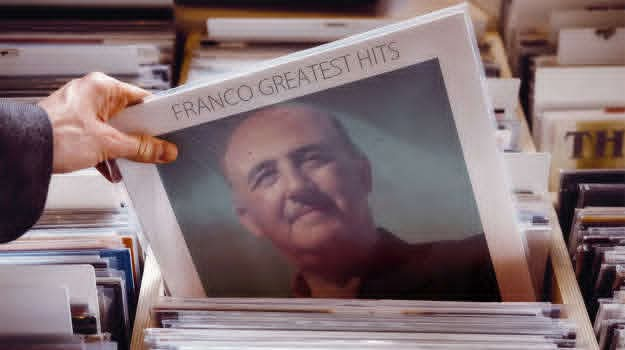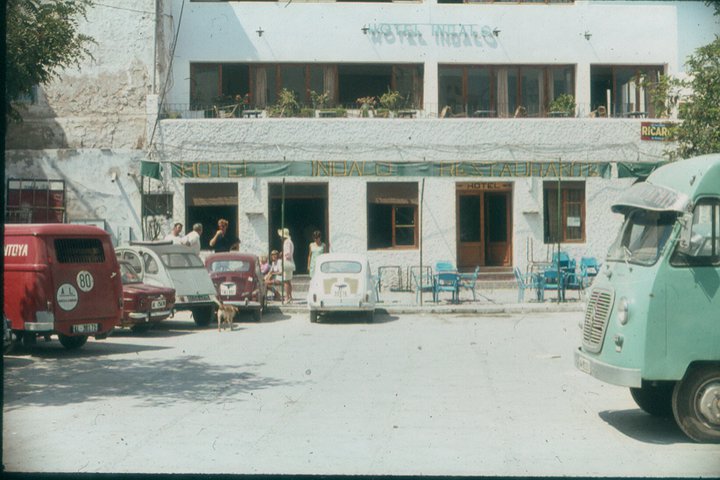Antifa Antidote
Saturday, December 20, 2025
From CBS News: What is Antifa? ‘In the USA, the right-wing media blames antifa members for rioting and looting. Democrats have also condemned such violence, but many on the left say the rhetoric about antifa (i.e., anti-fascist) is greatly exaggerated, and that it's less of an organized movement than just something of "an idea."
Swiss Info says: ‘Antifa, designated by US President Donald Trump as a "domestic terrorist organization," is a diffuse "anti-fascist" movement of left-wing activists that experts say is more of a political ideology than an organized group…’ We read: ‘Antifa, from the word anti-fascism, was already in use in Germany in the early 1930s, where "anti-fa" socialist groups tried to oppose the rise of Adolf Hitler's Nazis…’ 
For some reason, perhaps to escape the obvious point that our fathers and grandfathers fought, precisely, against fascism in the 1940s, the American right pronounces it ‘antee-fuh’ rather than ‘anti-fah’!
But much of what politicians say about antifa isn't quite true. Here's what antifa is and what it isn't.
Antifa is not a highly organized movement, nor is it merely an idea. Antifa is a loose affiliation of local activists scattered across the United States and a few other countries.
‘In general, people who identify as antifa are known not for what they support, but what they oppose: Fascism, nationalism, far-right ideologies, white supremacy, authoritarianism, racism, homophobia and xenophobia…’
Flag shaggers, antifeminists and fake-news merchants.
Some of us don’t like cockroaches either.
Here in Spain (where no one had ever heard of it until now) La Razón recently ran a piece titled ‘Antifa: the masked figures who want to stifle public debate. The United States is pushing to outlaw them, Spain to welcome them’.
Apparently, if you believe La Razón, which you most certainly shouldn’t, the country is swarming with them. The Spanish ABC posted in October: ‘Trump orders foreign anti-fascists to be designated as terrorist groups. A Trump advisor tells him to look at who belongs to these groups in Spain’.
No one - is the short answer to that, because it’s an opinion rather than an entity. 
Nevertheless, because it’s worth a shot, the Trump-admirer Santiago Abascal, the leader of Vox, has recently called for antifa to be declared as a terrorist organisation in Spain: the proposal to be debated in the National Parliament in February.
Perhaps, on sober reflection, what we really need to do is to ban the anti-antifa program.
And so we come to 'Polarisation'.
According to Google AI, ‘Political polarization is the growing ideological gap where political groups and individuals move away from moderate views towards extreme ends of the spectrum, creating deep divisions, increased hostility, and difficulty finding common ground…’ 20Minutos says ‘The scar of polarization: five million Spanish people have broken with family or friends due to political motives’. Their recent questionnaire asks if it’s happened to you. And then along comes Campofrío (the ham people) with their Christmas advert: Let’s get together and bury our differences (video)…
(I think they could have maybe dropped Ana Rosa Quintana from the advert).
I suppose - as Vox appears to be gaining support - my main worry is this:
Is Ol’ Santi planning a Spanish version of ICE (the United States Immigration and Customs Enforcement) where lump-heads get to wear combat gear and a mask as they round up anyone who looks like he didn’t come over in the Mayflower; maybe make it a more Spanish version, something like Franco himself would have approved of?
He'll need the approval of whoever will be running the PP when Spain next goes to the polls.
 1
Like
Published at 3:17 PM Comments (6)
1
Like
Published at 3:17 PM Comments (6)
Shopping for Food: the Early Days
Sunday, December 14, 2025
I’m writing this while sipping on a Marzipan brandy, a slightly peculiar cordial that comes in a tall and skinny bottle from the local Aldi supermarket.
It makes me think of the old days, when one’s Christmas preference was a bottle of El Gaitero, a sweet cider which is sold in a champagne bottle – because the *pop* as the cork is released is an important part of the seasonal celebration.
Also, it was cheap – indeed, it still is.
Good too, even when you’re drinking alone.
Long before they built an Aldi on the other side of the hill from where I’m living, my parents would have to take the cuatro latas (as the Renault 4s were known) along the coast to our market town – Vera – which in the early seventies had opened the area’s first supermarket: Emilio’s – which I am glad to see is still going, fifty years later. You could wander around and push exciting stuff into your basket: ‘impulse shopping’ had arrived (‘What on earth is this?’ my mother might ask as she eyed something new).
Locally, we had a few groceries. The best known was in the village square: Juana’s place. She ran the shop – you would point at the shelves and say in your best Spanish ‘uno por favor’, continuing until you (and Juana) were content. Later, and Juana would catch on fast to her new market, she nailed a sign outside the store which read ‘Foodings’. 
There was a fellow known as Tea-cosy Roger who lived in the back of the village, and one could drop by to ask him to pick up this or that in Almería (an hour and a half away) where he would go on the bus once a week. He always wore a colourful woolly hat, obviously knitted by his adoring mum. His front room had a single tin of mock-turtle soup on a shelf to underline his commercial spirit.
Later, a local eccentric called Ian would offer an even more interesting service – driving up now and then to a suburb of Benidorm in his BMW and trailer to pick up British sausages and other goodies, to be mobbed on his triumphant return.
Supplies also arrived by air, as friends flying out from the UK remembered to bring bacon and teabags mixed in with their luggage.
A shop in the local port of Garrucha would regularly be talked into ordering strange products by a salesman that only a foreigner could possibly like. Diego would mournfully say as I enthusiastically picked up his final carton of johannisbeersaft, ‘Well, thank God that’s gone, I’m never buying that again’. Next week, he’d have a special on Irish butter biscuits.
For proper meat, my parents would drive down to the nearest decent butcher, a German in Torremolinos. This would take several days for one reason and another.
And thus, we survived. The local milk came in a tall returnable bottle fitted with a metal bottle top (like a beer). It was slightly blue in colour thanks to the added formaldehyde. On the bright side, it never 'went off'. Butter came in a tin from Belgium. Pork, goat, chicken and eggs were easy to find in the local markets. When the fridges began to appear in the shops, we found Spain’s excellent yoghurts and ice-creams – although the milk would take a little longer to arrive, waiting for the twin inventions of UHT and Swedish tetra-brik packaging.
Simple times. One paid in pesetas and got one’s change either in small coins or sweets.
But these days, as our area shyly joins the 21st Century, we can now lay claim to several small supermarkets and four large ones, including the recently opened Aldi.
They are all playing Christmas music in their stores right now, which sort of explains how I ended up with a bottle of Marzipan brandy.
 3
Like
Published at 12:48 PM Comments (2)
3
Like
Published at 12:48 PM Comments (2)
Dividing up the Territories
Tuesday, December 9, 2025
I made a little joke the other day and put it on Facebook. Contemplating my mortality, I noted that I was nevertheless younger than Trump, Bibi and Putin (at 79, 76 and 73 respectively), and with a bit of luck, would outlive the three of them. Although, it’s true that they probably enjoy better medical attention than I do.
None of the three above-mentioned gentlemen appear to have any love for Spain. 
I’ll leave it to The Gentle Reader to agree or disagree about those three leaders – and perhaps a few others (Kim Jong Un springs to mind) who are jostling for position behind them for the Planetary Ogre Awards – and attempt instead to focus here on their enmity with Spain and indeed Europe.
Let’s see: Donald Trump is annoyed with Spain for not leading the re-armament of Nato, for failing to buy enough American military hardware and for letting in too many immigrants – particularly those of the coloured persuasion.
Bibi Netanyahu is crushed over our negative reaction to his country’s unwelcome presence in Eurovision, the issues over the Tour de España this past summer and also our unremitting anger against his genocidal activities in Palestine.
Vladimir Putin simply doesn’t like any country that backs Ukraine and he has threatened Europe with a ‘if you want war, I’ll give you war’. A nasty piece of work in my opinion.
As for his current occupation of as much of the Ukraine as he can obtain, it doesn’t appear that Donald Trump is as concerned as one might hope, as the recent American plan for the next two decades seems to suggest that they will be busy with their own back-yard, if one can so describe Venezuela and Columbia (and don’t forget Greenland), leaving Russia free to snaffle up bits of the old Soviet Union and presumably, allow Xi to absorb the lost province of Formosa, currently called Taiwan.
Meanwhile, the surviving bits of Europe can go play with our rigorously attached plastic bottle-caps.
Russia, too, is especially keen in manipulating the voting system in other countries to help the far-right, or (as in Catalonia in 2017) to divide the Europeans in any way that they can.
All these autocracies are actively trying to change our minds about this and that and they use fake-news, distortions, legions of preppy influencers, ample funding and false narratives to do so.
Europe, it would appear, has been having it too good, and we need to buckle down to the lofty ideals of our billionaires and pay more in taxes, take out private health insurance and keep working into our eighties.
We read that the Trump administration has just released its National Security Strategy, the blueprint for the next two decades. Trump, it appears, is against the influence of multilateralism – whether the United Nations, Nato or the European Union. ‘In recent days, the level of aggression against Brussels has reached an unprecedented level. Before, there have been many veiled attacks and insults, with malicious and condescending remarks, but now we are facing a full-blown assault, without any attempt at retraction, on the leadership and unity of Europe, because a divided bloc, where Euroscepticism grows, is better for them, just as it is for Russia. This way, we will be weak, and that leads to capitulation’, says El Huff Post.
That document announced the U.S. will back away from the global alliances formed in the wake of World War II and calls for making sure Nato, the organization that has opposed first Soviet and now Russian aggression since 1949, doesn’t continue to expand (so much for the Ukraine). The administration’s document calls for a world dominated not by a rules-based international order in which countries must respect each other’s sovereignty, but by a few major powers that control weaker nations in their sphere of influence.
The document also warns about Europe becoming less white, or as Trump says “Europe is facing the disappearance of its civilization” (unless we knuckle down). The BBC adds: at the same time ‘…the document hails the growing influence of "patriotic European parties" and says "America encourages its political allies in Europe to promote this revival of spirit".
"We want Europe to remain European," says the American plan. In a sort of far-right, anti-immigrant way.
And then there’s Elon Musk who is currently calling to 'Abolish the EU', for his own commercial reasons.
Russian officials appear to be happy with this U.S. foreign policy, and we read that ‘The Kremlin on Sunday welcomed US President Donald Trump’s move to stop calling Russia a direct threat and said his new national security strategy, which portrays European powers as in decline, largely accorded with Russia’s own perceptions’.
In short, it appears that a still disunited Europe is either on its own or must cozy up to the Chinese.
As the aggressive foreign powers attack us through fake-news, manufactured guilt, the Internet and Hollywood, we can only reply with our softer version of spreading our own culture through the Instituto Cervantes, the British Institute, the Goethe-Institut and so on.
Pedro Sánchez is one of our better statesmen, and he said in Los Cortes this Saturday during the celebrations of the anniversary of the Spanish Constitution that “Europe will never be under the tutelage of anyone, nor will it be a vassal of any political power or any national power from other geographical latitudes”. On Monday, the President of the European Council, António Costa, stated that the European Union would not accept any "threat of interference in European political life". He also referred to the U.S. document’s text which criticizes the "regulatory suffocation" of the European Commission.
Meanwhile, as Trump joyously received the FIFA’s peace prize, Pedro Sánchez was awarded the Mario Benedetti International Prize for the Fight for Human Rights and Solidarity 2025, an award he shares with the UN Special Rapporteur for the occupied Palestinian territories, Francesca Albanese.
Now, if we could just resolve the Ukraine issue in a sensible way.
 1
Like
Published at 6:20 PM Comments (9)
1
Like
Published at 6:20 PM Comments (9)
While I Was Enjoying a Few Days Off
Monday, December 1, 2025
Two rather hectic weeks have just passed here in Spain. Will things settle down again?
Probably not.
On the fiftieth anniversary of Franco’s death, last November 20th, the Supreme Court (five ‘conservatives’ and two ‘progressives’) abruptly announced, five to two and according to inclination, that they had found the Attorney General Álvaro García Ortiz to be guilty of passing secrets (without any proof – the concept of innocent until proven otherwise having apparently failed its test). The written sentence to be published in due course (it would need to be creative). It turns out that, coincidence abounds, three of the five were imparting remunerative classes in jurisprudence at the same time to the Colegio de Abogados de Madrid: one of the private accusations against the Attorney General.
The AG promptly fell on his sword and on November 25th, the (single) day when violence against women is remembered, Teresa Peramato was chosen to take his place.
The word ‘lawfare’ might have appeared here and there in the lefty media in recent reports.
And so, on to the next crisis: The Government has been rocked by the accusations against two of their members of Saving Something for a Rainy Day: the previous Party Organisation Secretary José Luis Ábalos, and his successor in the same post Santos Cerdán. Ábalos is now in ‘preventative custody’ against a ‘risk of escape’, evidently having forgotten to nip outside the morning before to buy a packet of smokes, more fool he.
Indeed, since Ábalos is (still) a deputy, he must be tried by the Supreme Court, which is a lot faster – they have far fewer cases – than the usual National Audience (where Cerdán, having given up his parliamentary seat, and thus his ‘aforo’, will one day be tried – I mean, they are just starting now on Jordi Pujol -poor chap, he’s 95- eleven years down the line!) The problem for Pedro Sánchez is that he’s lost a deputy (Ábalos, while no longer in the PSOE, had remained loyal as an independent). This puts him in an even worse space than before, with one less vote in the Chamber – unless Junts changes its mind.
Since we last spoke, Carlos Mazón has quit his post, and a deal between the PP and Vox has given the presidency of the Valencian region to Juan Francisco Pérez Llorca (PP). Mazón, who still has his ‘aforamiento’ (about 250,000 people in Spain enjoy this parliamentary immunity), and most of his monthly income, is dancing around the current judicial enquiry into what he was doing (or not doing) that day last year when 229 of his loyal subjects were drowned.
Over in Almería, while I was away, the president and vice-president of the provincial authority known as ‘la diputación’, in the hands of the PP, together with the PP mayor of Fines, were arrested, accused of corruption. ‘Pillowcases full of cash’ says one report. They have all now been chucked out of the party.
And this brings us to the Sunday demonstration in Madrid (to date, the seventh called by Feijóo), for all those – less the crowd from Almería – who would like to see Sánchez throw in the towel and call for elections, prior, as Feijóo said in a speech to the Faithful, ‘to joining his pals Koldo, Cerdán and Ábalos in the (rather comfortable-looking) Soto de Real prison’.
What a time to be in the flag manufacturing business!
The error of the PP is to continually harp on bringing down the Government (without success) which breeds frustration for their supporters rather than confidence. They might be better advised in promoting their own program – if they have one.
The PP’s likely future leader, the increasingly eccentric Isabel Díaz Ayuso was there, and she warned in a speech, about the threat from ETA – the dead duck terror group who handed in their guns a number of years ago. Apparently, they're plotting something with Sánchez.
So far, the leader of the Opposition hasn’t found enough support for a parliamentary motion of censure, so he appears to be putting his faith in a popular uprising. Feijóo had been trying to get support from the Junts per Catalunya people – they have seven seats in the Cortes – but they think it unlikely that he truly wants Carles Puigdemont, the exiled party leader, to be forgiven for trying to remove Catalonia from Spanish control back in 2017.
The Guardian says that ‘Felix Bolaños, Spain’s justice minister, said the PP and the far-right Vox party – which did not take part in Sunday’s demonstration – were fundamentally the same and were competing to see which could say the most outrageous things about the prime minister’.
Meanwhile, we are still waiting for the written sentence – the full resolution – from the Supreme Court in the Attorney General case (these normally come with or before the conviction) to iron out a few remaining doubts.
 0
Like
Published at 6:10 PM Comments (2)
0
Like
Published at 6:10 PM Comments (2)
The Attorney General is Canned
Sunday, November 23, 2025
The headline from Politico pretty much sums up the bombshell – practically up there with Franco’s infamous “bando de guerra’’ announcement as the beginning of Spain’s Civil War – ‘Spain’s top court ousts the Attorney General, escalating the prime minister’s feud with the judiciary’.
This is all to do with the lack of the Constitutional presumption of innocence; plus the coincidence that the ruling came out precipitously on November 20th (the 50th anniversary of Franco’s death and – by chance – the very day when the Almería PP collapsed in yet another scandal). The announcement of ‘Guilty’ itself a filtration (of all ironies), since the ruling itself hadn’t been written: the five conservatives in the Supreme Court voting according (apparently) to their politics rather than their understanding of jurisprudence and furthermore without proof of guilt beyond accusations from various far-right groups including Vox and the hate groups Manos Limpias and Hazte Oir.
The court banned the Attorney General Álvaro García Ortiz from holding public office for two years for allegedly leaking details of a tax probe involving the partner of Madrid’s regional leader Isabel Díaz Ayuso, a rising star among the country’s conservative voters. It further fined him 7,500 euros and ordered him to pay ‘the boyfriend’ (‘el Novio de Ayuso’) as Ayuso’s companion Alberto González Amador is habitually called, 10,000 euros for his troubles.
An opinion piece from the director of elDiario.es begins: ‘The lies of Miguel Ángel Rodríguez (Ayuso’s adviser) and Isabel Díaz Ayuso, the far-right accusations, the hoaxes, and those who published those falsehoods have won. The fraudulent middleman has won. Journalism that verifies the news has lost, the Attorney General has lost, the truth has lost. And justice has lost as well. Its image in the eyes of the public is once again tarnished by a conviction that is very difficult to explain…’
To further quote Politico: ‘Justice Minister Félix Bolaños said that the government was obliged “to abide by the sentence” and appoint a new attorney general. But he stressed the executive’s disagreement with the conviction and reaffirmed its belief in García Ortiz’s innocence’.
Cadena Ser has: ‘The president of the Progressive Union of Prosecutors says that "The Supreme Court has convicted an innocent man, and this will have profound consequences for trust in the justice system"’.
José Antonio Martín Pallín, emeritus magistrate of the Supreme Court, says "The ruling is the closest thing to a coup d'état".
Pedro Sánchez, speaking from Johannesburg on Sunday, said he accepted the sentence of the Supreme Court, but profoundly disagreed with it.
Indeed, everyone on the left is equally sure of the Attorney General’s innocence. The Podemos far-left leader: ‘First they went for Podemos, then they went for the Catalonians and now they’ve gone for the PSOE in a further example of a judicial coup’.
The previous mayor of Madrid Manuela Carmena says that ‘the ruling is deeply unfair’.
The Minister for Public Administration, Óscar López, expressed feeling a sense of "desolation, weariness and disbelief in many things," and announced that the Government will activate whatever mechanisms are necessary.
Yolanda Díaz (Sumar) says that the sentence is a judicial resolution without any incriminating evidence and that the ruling is directed against the coalition government.
Gabriel Rufián from ERC said, “The message is clear: Ayuso is untouchable”.
The five-to-two ruling of the seven judges within the tribunal, says elDiario.es, shows that ‘the division within the court inevitably raises doubts about the independence of the judiciary or its politicization. The PP's methodical strategy with the General Council of the Judiciary (CGPJ) has allowed it to control Supreme Court appointments for decades, giving the right wing an overwhelming majority in all its chambers’.
Finally, a legal opinion, made a day before the sentence was given: ‘This is the first time in Spanish history (this is truly historic, unlike the trivialities of Núñez Feijóo, for whom everything is historic) that a court has tried the Attorney General. And given that he is being tried, one would think it would be for a very serious crime. But we have become accustomed to trivializing crimes, always within the sphere of the Government and its President. We have become accustomed to victimless crimes fabricated from newspaper clippings that certain judges seize upon as if they were the most important professional matter of their lives, and which they investigate as if the Holy Inquisition would. The crime, if it exists, is insignificant, and only a diabolical mind could have transformed an official statement into a crime of revealing secrets. But that is the level of justice we have in Spain today, thanks to the alliance of judges and right-wing politicians…’
Let us not forget José Maria Aznar and his famous ‘Let him who can do something, do something!’
…
On the other hand, the president of the Community of Madrid – Isabel Díaz Ayuso – says that it had all been an attempt by Pedro Sánchez to "undermine" the separation of powers and an "attack by the State apparatus" against her boyfriend Alberto González Amador. El Huff Post asks: ‘Do we need to be reminded of what happened to Pablo Casado (the previous leader of the Partido Popular) when he accused Isabel Díaz Ayuso of bribery? Does anyone even know what has become of Pablo Casado? Do we also need to be reminded of what just happened to the Attorney General, who was accused by Ayuso's boyfriend?’
An opinion piece from La Sexta says that ‘According to Ayuso, the Supreme Court's ruling demonstrates that things typical of a "dictatorship" happen in Spain. A dictatorship in which she can freely spout whatever nonsense she pleases; her partner has been able to take an Attorney General to court and win; and the government has said it will abide by the ruling.
Indeed, it would appear that Ayuso's boyfriend decided on sober reflection neither to commit suicide nor to leave Spain (as he had threatened while speaking as a witness during the court case); on the contrary, he buys a luxury penthouse in the toniest part of Madrid (with, and excuse the joke, the AG providing the down-payment).
And what says the leader of Vox, Santiago Abascal? On Twitter he writes: “Álvaro García Ortiz is the first Attorney General to be convicted in the history of Spain. Pedro Sánchez will also be the first president in the history of Spain to end up in prison”.
…
On Sunday, hundreds of people demonstrated in front of the Palacio de Justicia in Madrid shouting ‘golpistas con toga’ (something like: ‘treacherous judges’).
On Monday, García Ortiz sent his letter of resignation to the Minister of Justice Félix Bolaños. It said in part: “Though my decision stems directly from the ruling, I’m convinced that I’ve faithfully served the institution to which I am honoured to belong, with an unequivocal vocation for public service, a sense of duty and institutional loyalty.”
Tuesday began with the proposal of a new attorney general: Teresa Peramato.
…
President Sánchez is becoming used to the lawfare by the judiciary against his wife, without any wrongdoing discovered after eighteen months despite a judge’s mediatic and continuous fishing attempts, and his brother, who obtained his rather unimpressive job as a music teacher in Badajoz before Sánchez was voted in as president.
The questions ordinary people might be considering include – If the Attorney General is convicted before the person who billed millions for masks with false invoices… what message does that send to anyone who investigates those in power? González Amador – a mere health technician – allegedly earned over two million euros selling face masks at the height of the pandemic and attempted to avoid paying any tax on the profits.
…
What is lawfare – I’m glad you asked: From Google IA: ‘Lawfare is "war through the courts," that is, the instrumental use of legal procedures to persecute, weaken, or harm political adversaries’.
…
The theory is that Franco may be fifty years dead, but Francoism is still a runner.
…
We are beginning to enter into election territory.
While Feijóo and Abascal, the leaders of the right and the far-right, need each other in a partnership (one which with Vox as the junior member no doubt wagging the tail of the dog), an alternative and vastly more attractive and bombproof leader waits in the wings: Ayuso.
This is what all the fuss is about. Ayuso is commendably far to the right, while still within the Partido Popular. She’s pretty and – unlike the inept Feijóo – she’s a vote-catcher.
 5
Like
Published at 10:09 PM Comments (0)
5
Like
Published at 10:09 PM Comments (0)
Franco Gone These Fifty Years
Sunday, November 16, 2025
There’s a Spanish word which has a very special meaning – or had at least, half a century ago – and it sounds odd to British ears: El Generalísimo, which might mean something like ‘the generaliest of all the generals’ practically a (what comes next – a field marshal?).
Anyway, I’m talking about El Caudillo, the Spanish dictator Francisco Franco, who after forty days and nights in the comfort of the intensive care unit at the Hospital de la Paz in Madrid, finally succumbed to his woes on November 20th these fifty years ago.
Not that you’d think it with all these fascist idiots still running around the city squares half a century on and giving what used to be called a Hitler salute.
There’s a story I like: Franco is in his hospital bed and there’s a crowd outside shouting. Franco – who is losing his facilities by this time – asks the doctor, ‘What are they saying?’ The doctor goes: ‘They’re saying adiós, adiós’.
‘Really?’ says Franco, ‘Where are they all going?’
In those times, Mojácar where I lived with my parents (when I wasn’t travelling somewhere) was a quiet and forgotten village with just a sprinkle of eccentric foreigners.
We never thought about Franco, and the Guardia Civil were chummy enough.
My father used to drop off a case of wine in the police barracks in next-door Turre every Christmas. It never hurts to have friends with silly hats and a pistol.
One day a few years before, back in 1971, the cops had come by on their mopeds and sorrowfully told my father and me that we would have to report to the local lock-up in Vera – a cavernous room under the ayuntamiento – as punishment for sawing down Mojácar’s first billboard, which had been erected by a Corsican fellow who had just opened the pueblo’s first souvenir shop.
He could obviously see which way things were going.
All we had with us was a bottle of Spanish lemonade (filled with vodka), a change of underwear, a couple of Ian Fleming novels and my dad’s radio. He liked to listen to the BBC’s World Service and appeared to be very disappointed when they failed to mention our incarceration.
We spent three days in the clink (I was just seventeen) and were due to face further punishment, but the British ambassador saved the day, and we were forgiven and our names removed from the records.
In Franco’s time, it helped to have un enchufe – a ‘good friend’ – and the ambassador had been to school with my dad. A few words in the right ear…
By 1975, Franco was on his last legs, and word reached us from the far-away outpost of Jávea in Alicante that the Swedes (I may be wrong about this) had decided to have a demonstration of their love and respect for Spain and so held a celebration with the famous, albeit fascist slogan Arriba España, which they had unfortunately translated on a large banner as ‘Up Spain’.
At last, El Caudillo finally died, and Spain entered into strict mourning. The bars were closed for three days, and solemn music was played on the radio and the one TV channel.
My father and some other foreign residents, being appraised of this tender moment in Spain’s history (as above, they found the pueblo’s only bar was unexpectedly shut), decided the thing to do would be to go to mass in our local iglesia and show our respects.
The priest was surprised to see us, as there was (as usual) no one else in Mojácar’s house of worship except a few old girls in black.
As we left, pulling off our neckties (those that still owned one) we found the mayor and a collection of irate locals waiting for us. Y’see, Mojácar had been a communist holdout during the civil war, and consequently, no one was sorry to see the old gangster go to his reward, such as it no doubt was.
‘Oops’, said my dad.
The tension grew until the Mayor Jacinto saved the day. ‘Antonio, go and unlock the bar. The foreigners are thirsty’.
I’m not sure, after all it was exactly fifty years ago, but I think we all drank champagne.
 5
Like
Published at 8:31 PM Comments (10)
5
Like
Published at 8:31 PM Comments (10)
I Always Wear a Seatbelt (I'm wearing one now)
Sunday, November 9, 2025
I needed a rag to check the oil on my old banger, so I was looking under the kitchen sink for a discarded tee-shirt.
There’s a pile of them down there, maybe my wife thought slinging them under the sink was easier than chucking them in the washing machine. Especially the sillier ones which I appear to have collected over the years.
This one was from some restaurant and had a large black diagonal stripe on it, looking like – if one was driving – a seatbelt. A treasure from back in 1975 when the new law came in.
I took it down to the restaurant to tease them, but it fell apart in my hands. After a mere half a century of neglect plus the work of a few moths: I call it poor quality.
Since I was there, I stayed for lunch.
Had a few drinks with the owner, Juan, and a couple of others.
Driving home (yes, yes, with my seatbelt fastened), I thought I’d take the secret back-route that only I (and a handful of local boozers) are familiar with. It’s a bit bumpy some of it, and I know I need to slow down on a particularly nasty stretch, but I got home safely, while my friend Ángel (not his real name, he’s actually called Eluterio) who took the main road got charged by the cops for driving with his eyes crossed. In Spain the legal limit is 0.5mg of alcohol per ml of blood (they want to drop it to 0.2mg). To compare, in the UK the limit is 0.8mg. I know, they claim Spain is a tourist paradise. Poor Ángel: five hundred euros, (250 if he pays up sharpish) and four points docked from his driving licence.
He’s a changed man these days…
Indeed, we sometimes call him up to be the designated driver. These days, he sits there in the corner twitching gently while playing with his mobile phone looking for the WhatsApp police-control warning page.
One day, they’ll invent self-driving cars and I’ve started a savings jam-jar in the kitchen to be ready. Imagine: ‘Helloo Car, my old mate (hic!), take me home via the liquor-store’.
Up in The Smoke, the traffic-tzar is an old blue-stocking who has been tightening the screws on all aspects of driving for several decades. Right now, as far as he’s concerned, a capful of una clara (beer with lemonade) will pretty much do the trick.
It’s all right for him though – he has a chauffeur. He can loll around in the back singing some popular number from Manolo Escobar (perhaps his catchy 'Somebody's Stolen my Donkey and his Cart') while the driver grinds his teeth and negotiates the M-30 in the rush-hour.
Mind you, and to make a point – you don’t need to drive ‘under the influence’ or indeed even completely sober for that matter if you live in Madrid or any other city in Spain. They have buses, taxis, trams and metros. You don’t even need to own a car.
And besides, there’s always a bar downstairs. Just use the lift (it’s free) to get home.
No, it’s us country-folk that have to take our lives (and everybody else’s) in our hands every time we go out shopping or to have lunch with a friend… and answer me this – how are the country-restaurants, with their reduced number of clients and their high social security outgoings, expected to make a dollar on their cheap menu del día and a glass of water?
So before you go drinking, always remember to plan ahead for your trip home.
…
My niece, who is a lawyer, tells me I must put a postscript here to say that I created the whole above story out of the cloth of fiction and that I don’t associate with drinkers and indeed I haven’t myself had a drop myself since the English won the World Cup: an admission which (except for the bit about the diagonal tee-shirt) I am happy to do.
 1
Like
Published at 9:13 AM Comments (2)
1
Like
Published at 9:13 AM Comments (2)
Jumanji - Sánchez' Ordeal in the Senate
Saturday, November 1, 2025
 El Senado de España, the Senate, is the Upper House – although perhaps more in the spirit than the reality: ‘…with more limited functions than elsewhere, as it is a chamber of second reading. Currently, it is composed of 208 elected senators and 58 senators appointed by the legislative assemblies of Spain's regions’, says wiki. In consequence, the senators – fine people all – are not necessarily in Spain’s front-rank of politicians. El Senado de España, the Senate, is the Upper House – although perhaps more in the spirit than the reality: ‘…with more limited functions than elsewhere, as it is a chamber of second reading. Currently, it is composed of 208 elected senators and 58 senators appointed by the legislative assemblies of Spain's regions’, says wiki. In consequence, the senators – fine people all – are not necessarily in Spain’s front-rank of politicians.
Over at El Senado, the Partido Popular has the majority, and the president of the house, Pedro Rollán, is from that august party. Indeed, of the 266 senators, only 92 are members or supporters of the Socialist Party, the PSOE.
Thus, the scene was set on Thursday in the Senate for a parliamentary committee hearing – something that is not a parliamentary debate and the questions are not those of a critical interview. A parliamentary committee hearing is an interrogation where the questioner's objective is not so much to seek the truth but rather to showcase their own skill in the fine art of tearing apart the person being questioned. So, on Thursday 30th October, for five hours, Pedro Sánchez was obliged to simply keep his composure while being asked, cross-examined and bullied regarding the various affronts of him, his family and his party – towards the Gracious and the Good.
Questions like – ‘answer ‘yes or no, did you…’ – straight out of a Peter Fauk TV show.
We remember last week’s delirious anticipatory remark from Feijóo: ‘if he lies, he’ll end up in court: if he tells the truth, then also’.
And yet… and yet… Pedro Sánchez came away after the ordeal, untouched. ‘This isn’t an examination, this is a circus’, said Sánchez at one point, making his opinion clear regarding the Senate's Commission of Inquiry into the Koldo case and other supposed issues.
Here's Gabrial Rufián on the interrogation: ‘The PP's handling of the Senate investigation went so well that the real news is that Sánchez has reading glasses. Yes, at 53 years old, our presi has to use spectacles (unless it was just a cunning ploy to distract us all along).
El Mundo (a leading conservative newspaper) writes: ‘Sánchez emerged unscathed from the circus; there was noise, but no wild beasts. The President's appearance before the Senate to answer questions from the Caso Koldo commission turned into an embarrassing political quagmire where the PP squandered the opportunity to shake up the PSOE’.
One question from a UPN senator was about the trips in his car with (the three villains) Koldo García, José Luis Ábalos, and Santos Cerdán. "Are you asking me how many people were riding in my Peugeot? Really? Well, Your Honour, it depended on the day", he answered to general laughter.
As somebody says – it was like an early and unwelcome Halloween for the opposition.
 1
Like
Published at 9:22 AM Comments (0)
1
Like
Published at 9:22 AM Comments (0)
nothing
Saturday, November 1, 2025
So, ahem, here's a picture.
The Mojácar village square in 1970 - the old Hotel Indalo, where it cost 60 ptas a night to stay, and about 5 ptas for a beer, 12 for a gin and tonic (Green Fish or Larios were the two brands in those days). 
 0
Like
Published at 9:13 AM Comments (1)
0
Like
Published at 9:13 AM Comments (1)
All Change
Tuesday, October 28, 2025
Last weekend we were obliged to put our clocks back, perhaps for one final time. Pedro Sánchez is the champion of those who don’t want any more time-changes and now the debate is advancing towards whether we citizens would prefer a permanent summer- or winter-hour clock. Indeed, Sánchez says that the European Commission had voted to change the system six years ago.
The Junts per Catalunya (the Government’s unwilling Catalonian conservative partner) was claiming last week – with some clever rhetoric – that rather than ‘change the hour’ it was ‘the hour of change’ with a plan to perhaps abandon their loose alliance with Pedro Sánchez early this week unless he sweetened his deal with this rather disagreeable party. On Monday, their exiled leader Carles Pugdemont, meeting with party members in Suresnes, France, ruled to drop any support for the now minority government in Madrid, unless it was something ‘that favoured Catalonia’. He however appears to have ruled out a Motion of Censure (the only other game in town being a PP/Vox combo which would be far more aggressive towards the independentists).
Some king-maker Carles will turn out to be.
Politics is often centred around criticism, and how the opposition could do things so much better. Feijóo is a great practitioner of this, and he has now called on Pedro Sánchez to explain himself in a long and no doubt tedious session to be held on Thursday in the PP-controlled Senate. Feijóo’s bon mot: "If he lies, he'll go to court, and if he tells the truth, he'll go to court too".
We shall be watching to see how that goes.
Spain has seventeen regions (plus Melilla and Ceuta). Most of these ‘autonomías’ are controlled by the PP either with or without apparent backing from Vox. Four of these are currently in deep water. All four – Andalucía, Castilla y León, Madrid and Valencia – are Partido Popular governments.
Andalucía particularly has a scandal centering around scans for breast cancer. Over the past few years – indeed, since April 2021 – the SAS has neglected to warn their patients of possible issues arising from the scans, and it now appears that a couple of thousand women (or maybe as much as ten times this number) were not told by the health service that they had complications of one sort or another. The president, Juanma Morales, telling the cameras that, see, they didn’t want to alarm the womenfolk. The issue is more to do with Andalucía’s ongoing push towards private hospitals and insurance. The public service being now generally considered as deficient.
The public prosecutor is reviewing the claims from Amama, an understandably irate women’s association of victims of breast cancer.
Andalucía has regional elections coming up in June 2026.
Castilla y Léon has the issue of the fires last summer, which were hopelessly faced by their president, Alfonso Fernández Mañueco, who failed to invest in prevention and even now, is cutting back on current levels of fire-services. 166,000 hectares were burnt there this summer (around 640 square miles). Another headache: there’s currently the Wind-farm trial going on in Valladolid – ‘considered the largest corruption case in the region’ – going back to earlier PP regional governments, with the court seeking some 250 million euros in fines and prison-time for the fifteen politicians and industrialists accused.
They have regional elections in CyL in March next year.
In Madrid, any number of scandals are in the news – from the president’s boyfriend’s tax-avoidance scams, to her waste of public funds (including the planned ‘won’t cost a penny’ Formula One racing circuit) and her participation in a publicly funded agency called Madrid Network that had generously paid large sums to PP stalwarts in the past. Isabel Díaz Ayuso is (or at least, she was) the likely successor to the inept Feijóo to lead the Partido Popular. However, we shall see…
Finally, there’s Valencia, still indignant over last year’s October 29th and its catastrophic flooding with the loss of 229 people. Where was the president that day? Having a long and leisurely lunch with a pretty journalist.  Avoiding phone calls and failing to send out a warning alert until it was all over (He arrived back at his office around 8.00pm, having apparently gone home to change clothes, only to be greeted with: ‘Presidente, hay muchos muertos’). Every final Saturday in the month since then, Valencia has turned out en masse to call for Carlos Mazón to resign. Today, 29th October, an official State Funeral presided by Felipe VI will be held in Valencia. Avoiding phone calls and failing to send out a warning alert until it was all over (He arrived back at his office around 8.00pm, having apparently gone home to change clothes, only to be greeted with: ‘Presidente, hay muchos muertos’). Every final Saturday in the month since then, Valencia has turned out en masse to call for Carlos Mazón to resign. Today, 29th October, an official State Funeral presided by Felipe VI will be held in Valencia.
In my picture, Mazón is comforted by Feijóo.
The first regional election on the calendar – for Extremadura – has just been announced for December 21st. The president there is María Guardiola (PP) who is frustrated because the opposition parties, including Vox, won’t accept her 2026 budget.
Change is in the air, and not only in the provinces. The 64-dollar question being, will Pedro Sánchez be forced to call for early general elections? It’s certainly getting tight.
 1
Like
Published at 7:53 PM Comments (1)
1
Like
Published at 7:53 PM Comments (1)
Spam post or Abuse? Please let us know
|
|